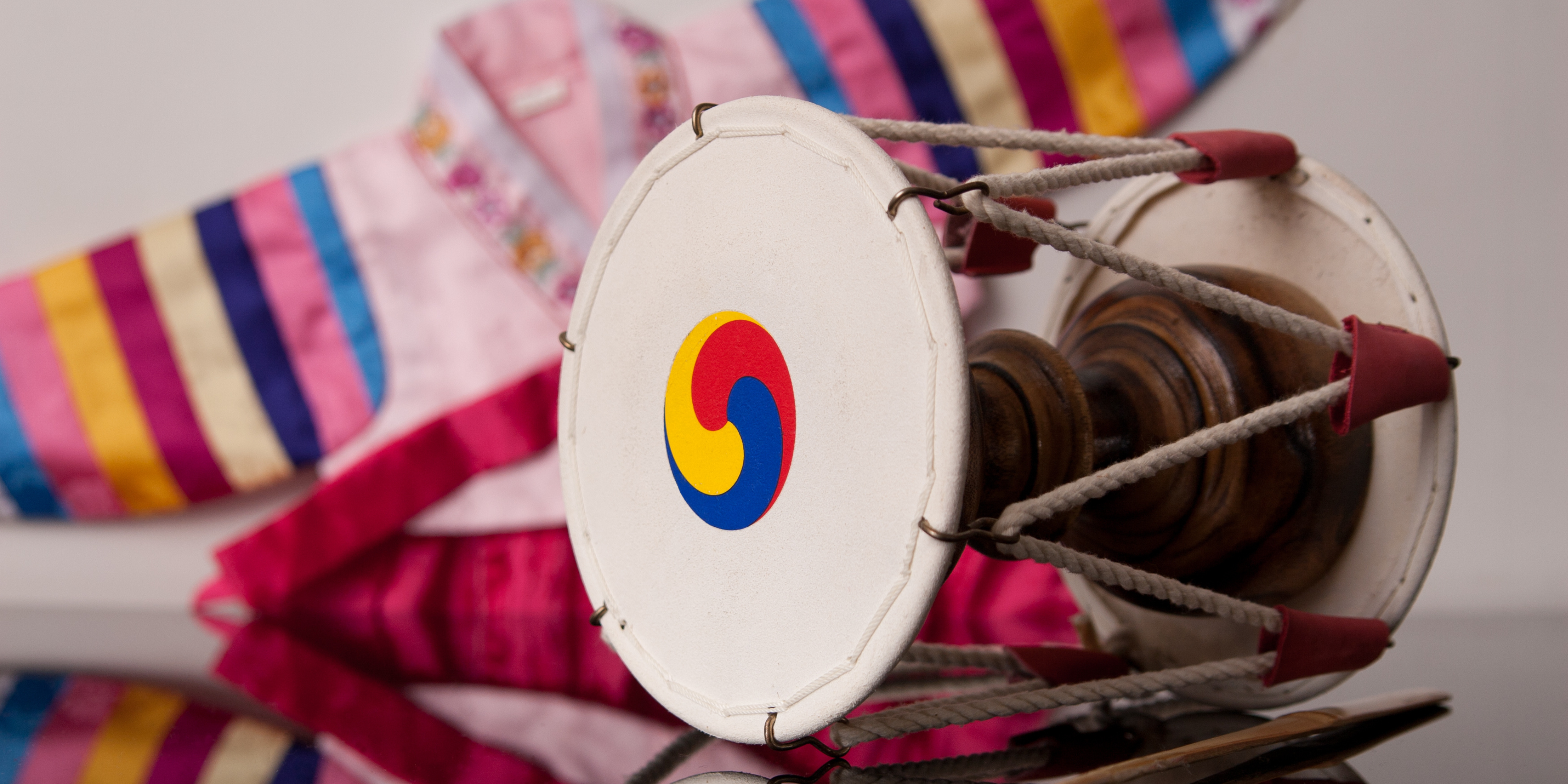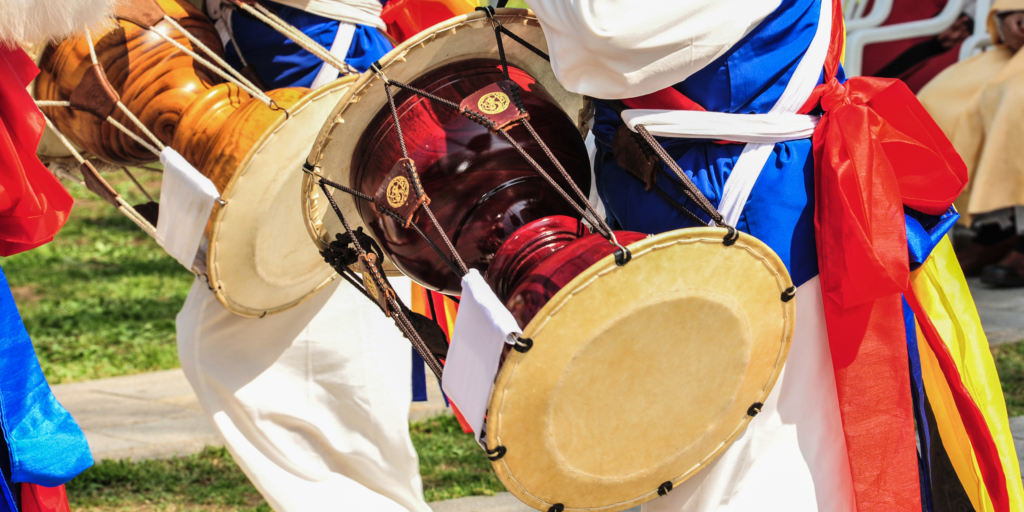
An integral part of engaging with a culture is experiencing its musical instruments and traditions. At Cultural Infusion, many of our educational workshops celebrate various cultures and traditions through distinct musical practices. In this blog, we will explore the interconnectedness of culture, music, and understanding by focusing on significant musical instruments from around the globe. Today’s spotlight is the Korean Janggu Drum.
Music is what’s known as a “cultural universal,” meaning every known culture in the world partakes in it, from the classical music of China to the Songlines used by Aboriginal and Torres Strait Islander Peoples. However, while a musical tradition is unique to a geographical location, it is also transcending time and space. An instrument, a scale, or a rhythm can travel miles and appear almost identically in a different tradition. Such is the case with the double harmonic scale, which can be heard in both Indian classical music and Arabic music, and with the cross-cultural 6/8 rhythm of lullabies. This means that tracking down the origins of an instrument is often a messy business, and it can be incredibly difficult to pinpoint exactly when and where an instrument has taken its modern form.
The story of an instrument is then ultimately the story of the many cultures and interactions that brought it to life. This is the case with our musical instrument of focus for this blog—the Korean Janggu Drum.

What is the Korean Janggu Drum?
The Korean janggu drum is a traditional musical instrument that has been integral to various forms of Korean music since the Goryeo Dynasty (918-1392). Also known as the double-headed Korean hourglass drum, its shape resembles an hourglass with a narrow middle section. The drum has two sides covered in leather, representing the union of yin and yang. The left side produces a bass tone, played with a gungchae mallet, while the right side produces a treble tone, played with a yeolchae stick. The drum’s tone can be adjusted using buckles for tuning. It can be played while strapped over the shoulder or while seated on the floor or a chair and comes in various sizes to accommodate men, women, and children.
The Korean janggu drum is made out of carefully selected empress tree wood. When deciding on a tree, the artisan would often bang on the tree to check its sound – the stronger the sound, the older the tree. After the tree is selected, a precious and elongated carving process begins. The sound of the drum is incredibly precious to the artisans, and even a slight deviation or miscalculation can waste a drum away. Hence, it takes years of dedication to master the art of making the Korean janggu drum.
The History of the Korean Janggu Drum
The origins of the janggu drum trace back to ancient Korea, with early references found in ancient records, describing rhythmic hand clapping in worship rituals. Artefacts from the Three Kingdoms period, including murals and statues, depict yogo, an early drum similar to the janggu, played alongside melodic instruments like the geomungo and dangbipa. In the Goryeo Dynasty (918-1392), records indicate the janggu drum was imported from China’s Song Dynasty and used in royal music performances. This is corroborated by Chinese historical texts from the Han Dynasty which also mention a similar drum called yogo.
By the 15th century, the Korean janggu drum was an essential instrument in both court and folk music, spanning genres such as jeongak, sanjo, japga, minyo, nongak, and shamanic music. Its versatility and cultural significance have cemented its place in Korean traditional music.
Traditional Uses of the Korean Janggu Drum
Drums are conceptualised differently across different cultures. In West African cultures, for example, the drum is used rhythmically to drive the beat of the piece. In Korea, however, the janggu drum, among other percussion instruments, is used to punctuate and add excitement to a piece by flowing in and out of it, rather than remaining as a constant throughout. This technique is used in Korean theatre, a prime example being pansori, a one-person lyrical opera that has the singer performing acapella with a lone janggu drummer providing often unexpected and impromptu musical responses to the story.
The Korean janggu drum is also used in various celebrations in both South Korea and North Korea, often accompanying dance performances. Among such festivals is the upcoming Dano Festival.
Celebrating Dano Festival with the Korean Janggu Drum
Dano Festival is a public holiday in North and South Korea to celebrate the start of summer and the end of spring. This year, it takes place on the 10th of June.
The holiday marks the start of the growing season, when farmers have finished sowing and planting, and Yang energy is at its highest level. Historically, this day was intended for spiritual rites and involved people dressing in blue and red. Traditionally, women wear dyed hairpins and men wear roots around their waists to ward off evil spirits. The celebrations often feature various dance performances accompanied by traditional instruments such as the korean janggu drum.
The largest Dano Festival celebration in the world occurs in the Gangneung Danoje Festival. People from all over Korea make their way to partake in these festivities, which include traditional the Gwanno mask drama, oral narrative poetry, and various popular pastimes. The festival also features Korea’s largest outdoor market where local products and original art is sold.
To help you celebrate Dano Festival, Cultural Infusion offers a Korean Classical Dance educational workshops in Victoria and New South Wales.
To keep up to date with upcoming cultural events, check out our cultural calendar. For other important dates in June, including National Reconciliation Week, World Environment Day and Matariki, check out our recent blog about dates to celebrate and commemorate in June.
Through experiencing and understanding musical traditions, we can gain a deeper appreciation for the cultures they originate from. The Korean janggu drum is just one example of how a single instrument can reflect the intersection of history, geography, and human interaction. By exploring the sounds and stories of instruments from around the world, we can foster a more connected and empathetic global community. Join us on this journey of cultural discovery with Cultural Infusion, where cultural education becomes a bridge to greater understanding and appreciation.
To find out more about our programs, please call us at 03 9412 6666 or email us at [email protected].
Sound Infusion
Also, if you’re curious to explore instruments from around the globe, take a tour of our award-winning platform, Sound Infusion. It offers a vast collection of original, high-quality samples, allowing you to create your own musical pieces by blending sounds from different cultures while learning about their history and function. Sound Infusion is part of our Learning Lands platform, which includes countless lesson plans and activities tailored to fit the Australian Curriculum. Book any program now and enjoy 3 months of Learning Lands for free!
Share this Post

